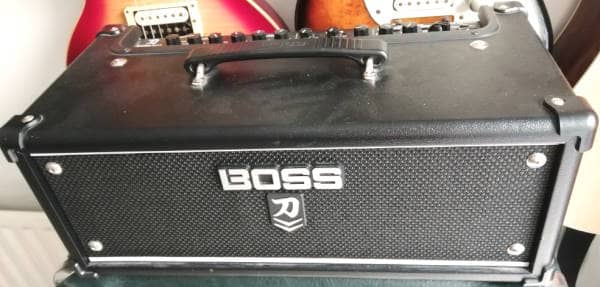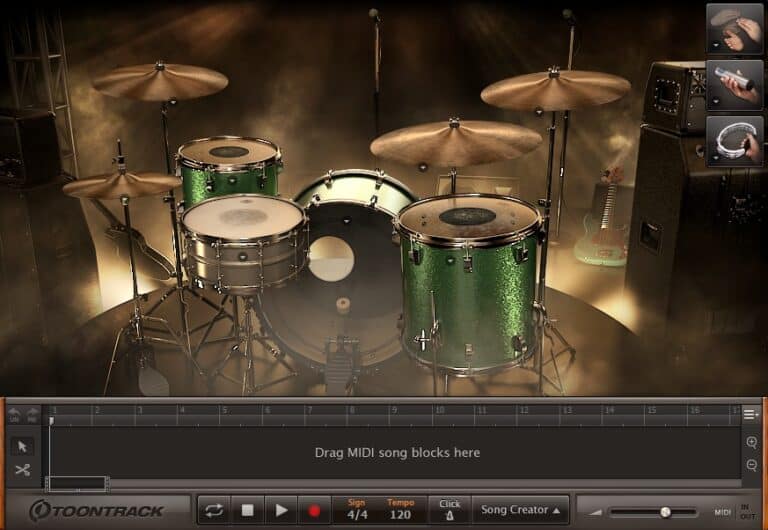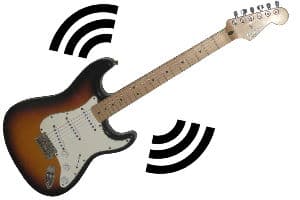Is Shure SM57 Good For Recording Acoustic Guitar?
DISCLOSURE: This post contains affiliate links. If you buy through these links, I may earn a small commission.
If you record music, at some point you’re probably going to want to record an acoustic guitar, most likely by placing a microphone in front of it. Can good results be obtained by using a standard multi-purpose dynamic microphone, such as a Shure SM57?
The Shure SM57 is a very capable microphone for recording an acoustic guitar. Its ability to eliminate unwanted noise make it a good choice to capture the acoustic guitar’s clarity and detail. Condenser microphones are the best option for acoustic guitar, but with care an SM57 can work well.
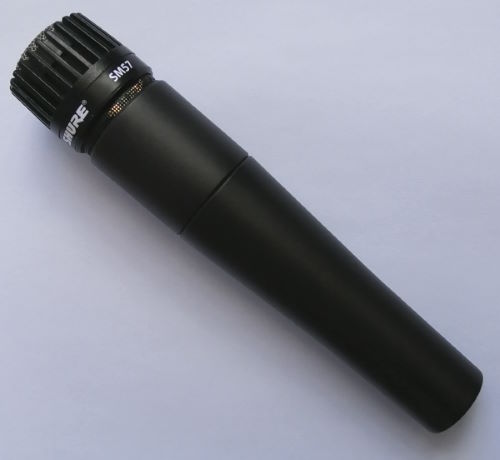
The SM57 is one of the most common microphones to be found in studios around the world, be it a big professional recording studio or a tiny bedroom setup. I have had an SM57 in my home studio for years. I am a firm believer that the best microphone for any task is the one you already have, and I have managed to obtain excellent results recording an acoustic guitar with an SM57. You can pick one up for a great price at Amazon here – Shure SM57 Dynamic Mic (affiliate link).
If you are interested in checking out the best recording gear such as audio interfaces, studio monitor speakers, microphones, etc., you can find them at Amazon by clicking here.
Recording acoustic guitar with an SM57
If you are completely new to home recording, I highly recommend you check out my beginner’s guide to recording music at home. This will help get you started with the recording process quickly and easily.
The key to recording the acoustic guitar with any microphone is placement.
The mistake a lot of novices make is to have the microphone too close to the guitar’s sound-hole, or too close to the body of the guitar in general. This effect is even more pronounced with a dynamic mic such as the SM57, as they have a tendency to emphasize the bass when getting close to a sound source. This can make your guitar sound muddy and unclear.
Place the microphone about 6 to 12 inches away from the sound-hole of your guitar. Experiment with the distance, but you don’t really want to get any closer than that. A quick tip that I then use is without moving the mic, turn it to diagonally face the guitar’s neck, around about the 12th fret. This can reduce some of the “boominess” you can get with a dynamic microphone, as the sound waves are not hitting the mic full-on from the front from the sound-hole.
One of the SM57’s big advantages is its ability to isolate a sound source i.e. it really focuses on the thing its recording and eliminates other background noise well.
Make sure that the back of the microphone is pointing towards a sound source you want eliminating e.g. if your computer makes an annoying hum, position the guitar and mic such that the back of the mic faces the computer while correctly positioned on the guitar.
We do this as the back of the microphone is where the most noise is rejected, so hopefully a lot of the computer hum will not be picked up. You can never eliminate the noise entirely, but the SM57 does a good job of rejecting a lot of the sound that isn’t aimed directly at the front of the microphone.
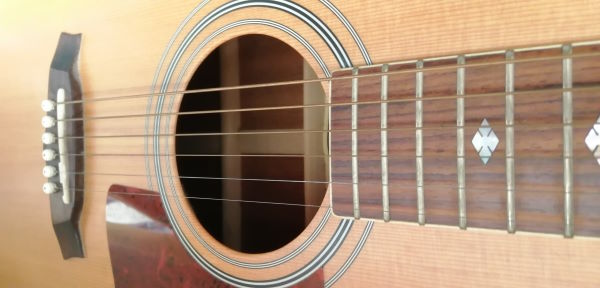
How far you place the microphone from the guitar will also depend on how loud the part is you are recording. You will probably want the mic closer if you are recording a soft finger-picked part, whereas for big strummed chords played with a pick you will probably want to move the mic further away.
Microphone placement when recording anything can be tricky to get right. With recording acoustic guitar, there are several other things you should watch out for. I have a guide on recording acoustic guitar with one microphone, which will help you set up your recording equipment to get the very best sound possible.
Do not worry about overloading the mic with loud playing – the SM57 is easily capable of coping with recording very loud sounds. This is one of the reasons it is such a popular microphone for recording guitar amplifiers and snare drums. Just be very careful of the level going into your interface; you may want to back off the gain on the input to ensure the signal is not clipping, causing unpleasant unwanted distortion.
The key to getting a good result with any microphone is to experiment. Try different positions in your room to find where your guitar sounds best. And remember that even subtle movements of the microphone can give pronounced changes in the recorded result.
This article is about recording an acoustic guitar with one SM57. But there are many situations where you might want to connect more than one mic to record them. That’s why I wrote this article on connecting multiple microphones to a computer. It’s highly recommended reading if you intend to record more than one mic at the same time, e.g. recording an acoustic guitar and a vocalist.
This video does a great job of demonstrating the effect different orientations of the SM57 can have on the recorded acoustic guitar sound…
If you follow these tips, you should be able to get a good recording with an SM57, with the clarity and detail from the acoustic guitar captured nicely. I have done this in my home studio many times, and have been pleased with the results.
One vital thing to get right is the recording level, i.e. how loud your record the signal from the microphone or guitar. Get this wrong, and you risk ruining a great take with unpleasant distortion. I have an article showing you exactly how to set the correct recording level every time when recording guitars.
Is SM57 the best mic for acoustic guitar?
While great results can be obtained using an SM57, it is not generally regarded as the best microphone to use on an acoustic guitar.
The SM57 is a dynamic microphone, whereas condenser microphones will usually give you the absolute best results when recording acoustics. They tend to be able to capture the high-end sparkle of the guitar better, particularly important if your guitar is going to be in a dense mix and has to stand out from the other instruments.
Condenser microphones range in price from a couple of hundred dollars up to 1000s of dollars. Professional recording studios are likely to have several very expensive condenser mics, but you can buy excellent condensers at a much lower price point.
A great example of an affordable condenser microphone ideal for a home studio is the Rode NT1A. You can pick one up for a competitive price from Amazon here – Rode NT1 Condenser Microphone Package (affiliate link).
Drawbacks of the SM57 on acoustic guitar
A criticism of the SM57 for acoustic guitar is that you have to get the microphone reasonably close to be effective, but that can cause problems with over-emphasizing the bass causing boominess and lead to a muddy recording. Angling the mic away from the sound-hole can help with this.
With the microphone so close, the effects of any movement of the guitar player are going to be amplified. No guitar player sits completely still, and you may have taken the time to really carefully place your mic, only to find the sound constantly changing as the guitarist naturally moves with his playing.
Condenser mics can generally work at a greater distance from the guitar than the SM57. Although they do give up some of the advantages the dynamic mic has regarding isolation and elimination of unwanted background noise.
Advantages of the SM57
In a home studio your budget is likely to be limited, and you are unlikely to be able to afford lots of different microphones for different purposes like a pro recording studio would. So even if the SM57 is not the perfect mic for an acoustic guitar, its other advantages as a general mic make it ideal for a home studio. If you can only afford one microphone, the SM57 is an excellent choice.
Some of the benefits of the SM57…
- Records loud sounds with ease (handles high SPLs – Sound Pressure Levels)
- Durability (these things are built like tanks!)
- Isolation (elimination of background noise)
- Price (under $100 – very cheap for a quality mic)
- Versatility (see next section)
You may choose an SM57, a different microphone or an entirely different method to record your acoustic guitar. For details of the available options for capturing an acoustic guitar on a computer, check out my “how to connect an acoustic guitar to a computer” article.
Other common uses for the SM57
It will be difficult to find a recording studio anywhere in the world that doesn’t have at least one SM57. One of the reasons for that is their versatility.
Perhaps the most common use for the SM57 is mic’ing up guitar amplifiers. Many of the great rock records have guitar sounds that were recorded using an SM57 close mic’d on a tube amp. Part of the reason for this is how loud a sound the SM57 can comfortably cope with – you can really crank an amp and the SM57 will handle it with ease.
Perhaps less well known is that they are often used on snare drums. Obviously these kick out a very loud transient peak in volume, which the SM57 captures well.
One often-overlooked use is as a vocal microphone. Perhaps not the first mic reached for when wanting to record vocals, it is however very capable for this purpose. Often used on female vocals, where you may want a little bit of the low end in the voice bringing to the forefront. I have recorded my own voice with an SM57 with good results (I have quite a high singing voice – it has several times been mistaken for a woman’s!)
Whichever microphone you use, you are going to need a good quality audio interface. With so many different interfaces available, it can be tricky to decide how big an interface you need. My “How many audio interface inputs do I need?” article will help you choose a suitable interface for your own personal musical requirements.
A great starter audio interface is the Focusrite Solo from Amazon (affiliate link), available from Amazon for a very reasonable price.
Conclusion
While the Shure SM57 might not be the very best mic for recording acoustic guitar, it is very capable and with the right positioning and orientation excellent results can be obtained.
While pro studios might reach for one of their high-end and high-price condenser microphones to use on an acoustic guitar, us mere mortals can have a lot of confidence in the SM57 to do the job. Add in the fact that its versatility means it can be used for many other things, I highly recommend getting an SM57 for your home studio.
Finally, before you go you may be familiar with making a recording, but there are unpleasant audio artifacts on it – pops or clicks. If this happens to you, my getting rid of interface pops and clicks article should help you find and eliminate the source of the unwanted sounds.
Here is some of my favorite home studio gear…
Thanks for reading this article. I hope you found it helpful in your home music-making activities. Here are a few of the tools that I personally use in my home studio. These are affiliate links, so if you decide to use any of them I’ll earn a small commission.
Audio interface: My personal choice for audio interfaces are the Focusrite Scarlett series. I have been using these for years, and they have always given me great-sounding recordings. For a very reasonable price from Amazon you can buy the excellent Focusrite Scarlett 4i4, or if you don’t need MIDI capability the Focusrite Solo is a great choice.
Amp sim: Guitar amplifier simulator software has come on leaps and bounds in recent years, such that I record all my electric guitar parts using amp sims these days. One of the very best is the incredible Amplitube from IK Multimedia, which I have used on many of my songs.
Headphones for recording: My favorite headphones for recording are the Sony MDR-7506s, which I use for monitoring during all my recording sessions. They can also be found in many pro recording studios. Get the Sony MDR-7506 headphones from Amazon here.
General-purpose microphone: You can’t go wrong with a good ol’ Shure SM-57, one of the most versatile and ubiquitous microphones around. I’ve been using one in my home studio for as long as I can remember. Amazon offers the Shure SM-57 for a very competitive price.
To see all of my most up-to-date recommendations, check out this resource I made for you!


